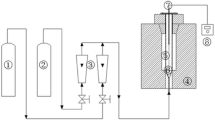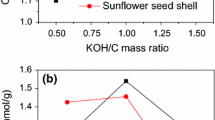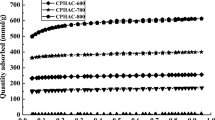Abstract
An increasing level of carbon dioxide (CO2) in the atmosphere has ultimately resulted in global warming and climate change. The high-performance activated carbon (AC-WL) was synthesized from walnut shell, a low-cost biomass by-product, by physical activation using a tube furnace. The adsorption behavior of CO2 from the CO2/N2 mixture was investigated using a fixed bed. The surface and morphological characterizations of the produced activated carbons were measured using a BET analyzer and a scanning electron microscope (SEM). The effect of temperature, flow rate, CO2 level, and partial pressure on breakthrough behavior was analyzed, and the adsorption response presented in terms of breakthrough point and adsorption capacity. The breakthrough and saturation periods vary significantly with change in temperature. The steepness of the breakthrough curves signifies good utilization of adsorbent capacity at breakthrough point. The increase in temperatures and flow rates lead to an increase in the length of mass transfer zone. The adsorption capacity of 1.58 mmol/g was obtained at 1.30 bars and 293 K with higher capacity utilization factor of 0.8492.These results suggest that the walnut-based activated carbon is favorable for capturing CO2.












Similar content being viewed by others
References
Al Mesfer MK, Danish M (2018) Breakthrough adsorption study of activated carbons for CO2 separation from flue gas. J. Environ Chem Eng 6:4514–4524
Al Mesfer MK, Danish M, Fahmy MY, Rashid MM (2018) Post combustion CO2 capture with activated carbons using fixed bed adsorption. Heat Mass Transf 54:2715–2724
Al-Janabi N, Vakili R, Kalumpasut P, Gorgojo P, Siperstein FR, Fan X (2018) Velocity variation effect in fixed bed columns: a case study of CO2 captures using porous solid adsorbents. AICHE J 64:2189–2197
Alonso M, Rodriguez N, Gonzalez B, Grasa G, Murillo R, Abanades JC (2010) Carbon dioxide capture from combustion flue gases with a calcium oxide chemical loop: experimental results and process developments. Int J Greenh Gas Control 4:167–173
Calvo-Munoz EM, Garcia-Mateos FJ, Rosas R-MJ, Cordero T (2016) Biomass waste carbon materials as adsorbents for CO2 capture under post-combustion conditions. Front Mater 3:1–14
Cohen SM, Chalmers HL, Webbe ME, King CW (2011) Comparing post-combustion carbon dioxide capture operation at retrofitted coal-fired power plants in the Texas and Great Britain electric grids. Environ Res Lett 6:1–14
Coromina HM, Walsh DA, Mokaya R (2016) Biomass-derived activated carbon with simultaneously enhanced CO2 uptake for both pre and post combustion capture applications. J Mater Chem A 4:280–289
Davis E, Kopac J (2014) Activated carbons derived from residual biomass pyrolysis and their CO2 adsorption capacity. J Anal Appl Pyrolysis 110:322–332
Dejang N, Somprasit O, Chindaruksa S (2015) Preparations of activated carbon from Macadamia shell by microwave irradiation activation. Energy Procedia 79:727–732
Garcia S, Gil MV, Martin CF, Pis JJ, Rubiera F, Pevida C (2011) Breakthrough adsorption study of a commercial activated carbon for pre-combustion carbon dioxide capture. Chem Eng J 171:549–556
Hao W, Bjorkman E, Lilliestrale M, Hedin N (2013) Activated carbon prepared from hydrothermally carbonized waste biomass used as adsorbent for CO2. Appl Energy 112:526–532
Hong S, Jang E, Dysart D, Pol VG, Lee KB (2016) CO2 capture in the sustainable wheat-derive activated microporous carbon compartments. Sci Rep 6:1–10
Jahangiri M, Shahtaheri SJ, Adl J, Rashidi A, Kakooei H, Forushani AR, Nasiri G, Ghorbanali A, Ganjali MR (2012) Preparation of activated carbon from walnut shell and its utilization for manufacturing organic-vapor respirator cartridge. Fresenius Environ Bull 21:1508–1514
Lewicka K (2017) Activated carbons prepared from hazelnut shells, walnut shells and peanut shells for high CO2 adsorption. Pol J Chem Technol 19:38–43
Li J, Ma Y, McCarthy M, Sculley J, Yu J, Jeong H, Balbuen P, Zhou H (2011) Carbon dioxide-related gas adsorption and separation in metal-organic frameworks. Coord Chem Rev 255:1791–1823
Lira-Zuniga S, Saez-Navarrete C, Rodrigues-Cordova L, Herrera-Zeppelin L, Herrera-Urbina R (2016) CO2 adsorption on agricultural biomass combustion ashes. Maderas Cienc Technol 18:607–616
Lu C, Bai B, Wu B, Su F, Hwang JF (2008) Comparative study of CO2 capture by carbon nanotubes, activated carbons, and zeolites. Energy Fuel 22:3050–3056
MacDowell N, Florin N, Buchard A, Hallett J, Galindo A, Jackson G, Adjman C, Williams CK, Shah N, Fennel P (2010) An overview of carbon dioxide capture technologies. Energy Environ Sci 3:1645–1669
Mataji M, Khoshandam B (2014) Benzene adsorption on activated carbon from walnut shell. Chem Eng Commun 201:1294–1313
Monazam ER, Spenik J, Shadle LJ (2013) Fluid bed adsorption of carbon dioxide on immobilized polyethylenimine (PEI): kinetic analysis and breakthrough behaviour. Chem Eng J 223:795–805
Patil P, Singh S, Kumar YM (2013) Preparation and study of properties of activated carbons produced from agricultural and industrial waste shells. Res J Chem Sci 3:12–15
Peredo-Mancilla D, Hort C, Ghimbeu CM, Jeguirim M, Bessieres D (2018) CO2 and CH4 adsorption behaviour of biomass-based activated carbons. Energies 22:1–12
Plaza MG, Duran I, Querejeta N, Rubiera F, Pevida C (2016) Experimental and simulation study of adsorption in post combustion conditions using a microporous biochar.1. CO2 and N2 adsorption. Ind Eng Chem Res 55:3097–3112
Plaza MG, Pevida C, Arias B, Fermoso J, Casal MD, Martin CF, Rubiera F, Pis JJ (2019) Development of low-cost biomass-based adsorbents for postcombustion CO2 capture. Fuel 88:2442–2447
Pota AA, Mathews AP (1999) Effect of particle stratification on fixed bed adsorber performance. J Environ Eng 8:705–711
Rashidi NA, Yusuf S (2016) An overview of activated carbons utilization for the post combustion carbon dioxide captures. J CO2 Util 13:1–16
Serafin J, Narkiewicz U, Moraeski AW, Wrobel RJ (2017) Highly microporous activated carbons from biomass for CO2 capture and effective micropores at different conditions. J CO2 Util 18:73–79
Serna-Guerrero R, Sayari A (2010) Modeling adsorption of CO2 on amine functionalized mesoporous silica. 2: kinetics and breakthrough curve. Chem Eng J 161:182–190
Shahkarami S, Azargohar R, Dalai AK, Soltan J (2015) Breakthrough CO2 adsorption in bio-based activated carbons. J Environ Sci 34:68–76
Shen C, Grande CA, Li P, Yu J, Rodrigues AE (2010) Adsorption equilibria and kinetics of CO2 and N2 on activated carbon beads. Ind Eng Chem Res 47:4883–4890
Shen C, Yu J, Li P, Grande CA, Rodrigues AE (2011) Capture of CO2 from flue gas by vacuum pressure swing adsorption using activated carbon beads. Adsorption 17:179–188
Sun Z, Srinivasakannan C, Liang J, Duan X (2019) Preparation and characterization of shiitake mushroom-based activated carbon with high adsorption capacity. Arab J Sci Eng 44(6):5443–5456
Toprak A, Kopac T (2017) Carbon dioxide adsorption using high surface area activated carbons from local coals modified by KOH, NaOH and ZnCl2 agents. Int J Chem React Eng 15:1–16
Valverde JM, Pontiga F, Soria-Hoyo C, Quintanlla MAS, Moreno H, Duran FJ, Espin MJ (2011) Improving the gas solids contact efficiency in a fluidized bed of carbon dioxide adsorbent fine particles. Phys Chem Chem Phys 13:14906–14909
Xia H, Cheng S, Zhang L, Peng J (2016) Utilization of walnut shell as a feedstock for preparing high surface area activated carbon by microwave induced activation: effect of activation agents. Green Process Synth 5:7–12
Yang H, Xu Z, Fan M, Gupta R, Slimane RB, Bland AE, Wright I (2008) Progress in carbon dioxide separation and capture: a review. J Environ Sci 20:14–27
Zeng G, Lou S, Ying H, Wu X, Dou X, Ai N, Wang J (2018) Preparation of microporous carbon from Sargassum horneri by hydrothermal carbonization and KOH activation for CO2 capture. J Chem 2018:1–9
Zhang C, Song W, Ma Q, Xie L, Zhang X, Guo H (2016) Enhancement of CO2 capture on biomass-based carbon from black locust by KOH activation and ammonia modification. Energy Fuel 305:4181–4190
Acknowledgments
The authors are thankful for Deanship of Scientific Research, King Khalid University, Abha KSA.
Author information
Authors and Affiliations
Corresponding author
Ethics declarations
Conflict of interest
The authors declares that there is no conflict of interest
Additional information
Responsible editor: Tito Roberto Cadaval Jr
Publisher’s note
Springer Nature remains neutral with regard to jurisdictional claims in published maps and institutional affiliations.
Rights and permissions
About this article
Cite this article
Al Mesfer, M.K. Synthesis and characterization of high-performance activated carbon from walnut shell biomass for CO2 capture. Environ Sci Pollut Res 27, 15020–15028 (2020). https://doi.org/10.1007/s11356-020-07934-x
Received:
Accepted:
Published:
Issue Date:
DOI: https://doi.org/10.1007/s11356-020-07934-x




